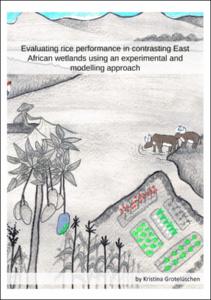Grotelüschen, Kristina: Evaluating rice performance in contrasting East African wetlands using an experimental and modelling approach. - Bonn, 2021. - Dissertation, Rheinische Friedrich-Wilhelms-Universität Bonn.
Online-Ausgabe in bonndoc: https://nbn-resolving.org/urn:nbn:de:hbz:5-63991
Online-Ausgabe in bonndoc: https://nbn-resolving.org/urn:nbn:de:hbz:5-63991
@phdthesis{handle:20.500.11811/9346,
urn: https://nbn-resolving.org/urn:nbn:de:hbz:5-63991,
author = {{Kristina Grotelüschen}},
title = {Evaluating rice performance in contrasting East African wetlands using an experimental and modelling approach},
school = {Rheinische Friedrich-Wilhelms-Universität Bonn},
year = 2021,
month = oct,
note = {Rice (Oryza spp.) has become an important staple food and cash crop across East Africa, and is now playing a pivotal role in regional food security and national economies. Since regional rice yields remain low, intensification efforts increasingly focus on wetland areas due to favourable climatic and hydro-edaphic conditions. Among these focal areas are the Kilombero floodplain in southeast Tanzania and the numerous inland valley swamps in central Uganda.
We combined experimental and modelling approaches to assess differential yield responses to improved management and hydro-edaphic field conditions (hydrological floodplains' fringe and middle, and toposequence cross-section of the inland valley), and the use efficiency and profitability of N fertiliser using 3-years of experimental and 30-years of simulated data.
Against average regional lowland rice yields of <2 Mg ha-1, yields of between 3.2-9.2 Mg ha-1 in the floodplain and of between 1.9-6.3 Mg ha-1 in the inland valley were attained, depending on management (rainfed 0 and 60 kg N ha-1, irrigated 120 kg N ha-1 + 60 kg PK ha-1), field position and year. The APSIM model performed well for grain yield in both wetland types, as supported by numerous goodness-of-fit measures during model validation. Additionally, so-called 'carry-over' effects were simulated accurately, i.e., continuous soil moisture contents, soil carbon dynamics, and indigenous N supply. Results further emphasised the importance of water tables for lowland rice production and sound model performance as they evidently attenuated seasonal droughts. Furthermore, yield determinants from hydro-edaphic field conditions were delineated via simulated spatial-temporal abiotic stress patterns (water and N stress). In both wetlands, low soil N was the main constraint, while drought stress affected rice performance more in the inland valley, in years of low seasonal rainfall and from lower water table supply capacities. Long-term (30-years) scenario analysis of yield responses to and partial gross margins of N fertiliser indicated high fertiliser use efficiencies, i.e., with yield gains of 1.7-4.5 Mg ha-1 in the floodplain and 1.0-3.2 Mg ha-1 in the inland valley, and profitable N rates of 30-120 kg N ha-1 in the fringe and 30-90 kg N ha-1 in the middle position of the floodplain, and of 60-150 kg N ha-1 in the inland valley. However, fertiliser use was comparably riskier in the valley-fringe position of the inland valley. Supplemental irrigation effectively increased yields, particularly in the valley-fringe position and may help boost fertiliser use efficiency and profitability.
The APSIM model proved a valuable tool in prioritizing production constraints, assessing management options and thus in guiding the decision-making on crop management in wetlands. These finding may help to align regional self-sufficiency and conservation targets through site- and system-specific targeting of management options.},
url = {https://hdl.handle.net/20.500.11811/9346}
}
urn: https://nbn-resolving.org/urn:nbn:de:hbz:5-63991,
author = {{Kristina Grotelüschen}},
title = {Evaluating rice performance in contrasting East African wetlands using an experimental and modelling approach},
school = {Rheinische Friedrich-Wilhelms-Universität Bonn},
year = 2021,
month = oct,
note = {Rice (Oryza spp.) has become an important staple food and cash crop across East Africa, and is now playing a pivotal role in regional food security and national economies. Since regional rice yields remain low, intensification efforts increasingly focus on wetland areas due to favourable climatic and hydro-edaphic conditions. Among these focal areas are the Kilombero floodplain in southeast Tanzania and the numerous inland valley swamps in central Uganda.
We combined experimental and modelling approaches to assess differential yield responses to improved management and hydro-edaphic field conditions (hydrological floodplains' fringe and middle, and toposequence cross-section of the inland valley), and the use efficiency and profitability of N fertiliser using 3-years of experimental and 30-years of simulated data.
Against average regional lowland rice yields of <2 Mg ha-1, yields of between 3.2-9.2 Mg ha-1 in the floodplain and of between 1.9-6.3 Mg ha-1 in the inland valley were attained, depending on management (rainfed 0 and 60 kg N ha-1, irrigated 120 kg N ha-1 + 60 kg PK ha-1), field position and year. The APSIM model performed well for grain yield in both wetland types, as supported by numerous goodness-of-fit measures during model validation. Additionally, so-called 'carry-over' effects were simulated accurately, i.e., continuous soil moisture contents, soil carbon dynamics, and indigenous N supply. Results further emphasised the importance of water tables for lowland rice production and sound model performance as they evidently attenuated seasonal droughts. Furthermore, yield determinants from hydro-edaphic field conditions were delineated via simulated spatial-temporal abiotic stress patterns (water and N stress). In both wetlands, low soil N was the main constraint, while drought stress affected rice performance more in the inland valley, in years of low seasonal rainfall and from lower water table supply capacities. Long-term (30-years) scenario analysis of yield responses to and partial gross margins of N fertiliser indicated high fertiliser use efficiencies, i.e., with yield gains of 1.7-4.5 Mg ha-1 in the floodplain and 1.0-3.2 Mg ha-1 in the inland valley, and profitable N rates of 30-120 kg N ha-1 in the fringe and 30-90 kg N ha-1 in the middle position of the floodplain, and of 60-150 kg N ha-1 in the inland valley. However, fertiliser use was comparably riskier in the valley-fringe position of the inland valley. Supplemental irrigation effectively increased yields, particularly in the valley-fringe position and may help boost fertiliser use efficiency and profitability.
The APSIM model proved a valuable tool in prioritizing production constraints, assessing management options and thus in guiding the decision-making on crop management in wetlands. These finding may help to align regional self-sufficiency and conservation targets through site- and system-specific targeting of management options.},
url = {https://hdl.handle.net/20.500.11811/9346}
}






